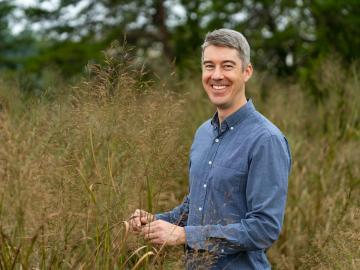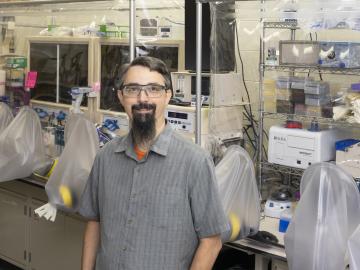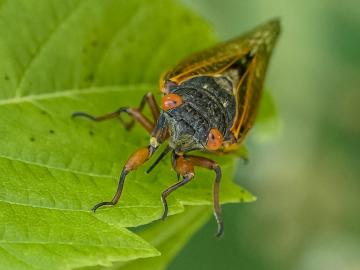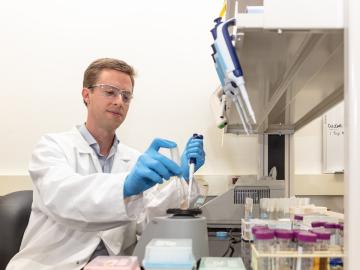
Filter News
Area of Research
- Advanced Manufacturing (3)
- Biological Systems (1)
- Biology and Environment (71)
- Computational Biology (1)
- Computer Science (1)
- Electricity and Smart Grid (1)
- Energy Science (34)
- Functional Materials for Energy (1)
- Fusion and Fission (6)
- Isotopes (4)
- Materials (25)
- Materials for Computing (5)
- National Security (9)
- Neutron Science (62)
- Nuclear Science and Technology (2)
- Quantum information Science (1)
- Supercomputing (49)
News Type
News Topics
- (-) Bioenergy (74)
- (-) Biology (86)
- (-) Biomedical (46)
- (-) Exascale Computing (53)
- (-) Frontier (47)
- (-) Neutron Science (95)
- 3-D Printing/Advanced Manufacturing (73)
- Advanced Reactors (17)
- Artificial Intelligence (85)
- Big Data (49)
- Biotechnology (25)
- Buildings (37)
- Chemical Sciences (46)
- Clean Water (16)
- Composites (15)
- Computer Science (127)
- Coronavirus (23)
- Critical Materials (6)
- Cybersecurity (20)
- Education (2)
- Emergency (3)
- Energy Storage (47)
- Environment (130)
- Fossil Energy (6)
- Fusion (47)
- Grid (35)
- High-Performance Computing (92)
- Hydropower (6)
- Irradiation (1)
- Isotopes (41)
- ITER (5)
- Machine Learning (39)
- Materials (82)
- Materials Science (75)
- Mathematics (8)
- Mercury (7)
- Microelectronics (3)
- Microscopy (31)
- Molten Salt (3)
- Nanotechnology (29)
- National Security (67)
- Nuclear Energy (79)
- Partnerships (42)
- Physics (40)
- Polymers (14)
- Quantum Computing (37)
- Quantum Science (52)
- Security (19)
- Simulation (46)
- Software (1)
- Space Exploration (14)
- Statistics (2)
- Summit (42)
- Transportation (41)
Media Contacts

Research teams from the Department of Energy’s Oak Ridge National Laboratory and their technologies have received seven 2021 R&D 100 Awards, plus special recognition for a COVID-19-related project.

Matthew Ryder has been named an emerging investigator by the American Chemical Society journal Crystal Growth and Design. The ACS recognized him as “one of an emerging generation of research group leaders for his work on porous materials design.”

For ORNL environmental scientist and lover of the outdoors John Field, work in ecosystem modeling is a profession with tangible impacts.

As a medical isotope, thorium-228 has a lot of potential — and Oak Ridge National Laboratory produces a lot.

As the United States transitions to clean energy, the country has an ambitious goal: cut carbon dioxide emissions in half by the year 2030, if not before. One of the solutions to help meet this challenge is found at ORNL as part of the Better Plants Program.

As a metabolic engineer at Oak Ridge National Laboratory, Adam Guss modifies microbes to perform the diverse processes needed to make sustainable biofuels and bioproducts.

ASM International recently elected three researchers from ORNL as 2021 fellows. Selected were Beth Armstrong and Govindarajan Muralidharan, both from ORNL’s Material Sciences and Technology Division, and Andrew Payzant from the Neutron Scattering Division.

On the road leading to Oak Ridge National Laboratory, drivers may notice that many of the green trees lining the entrance to the lab are dappled with brown leaves. Just weeks past the summer solstice, this phenomenon is out of place and is in fact evidence of another natural occurrence: cicada “flagging.”

Scientists at ORNL and the University of Wisconsin–Madison have discovered that genetically distinct populations within the same species of fungi can produce unique mixes of secondary metabolites, which are organic compounds with applications in

In a step toward increasing the cost-effectiveness of renewable biofuels and bioproducts, scientists at ORNL discovered a microbial enzyme that degrades tough-to-break bonds in lignin, a waste product of biorefineries.


